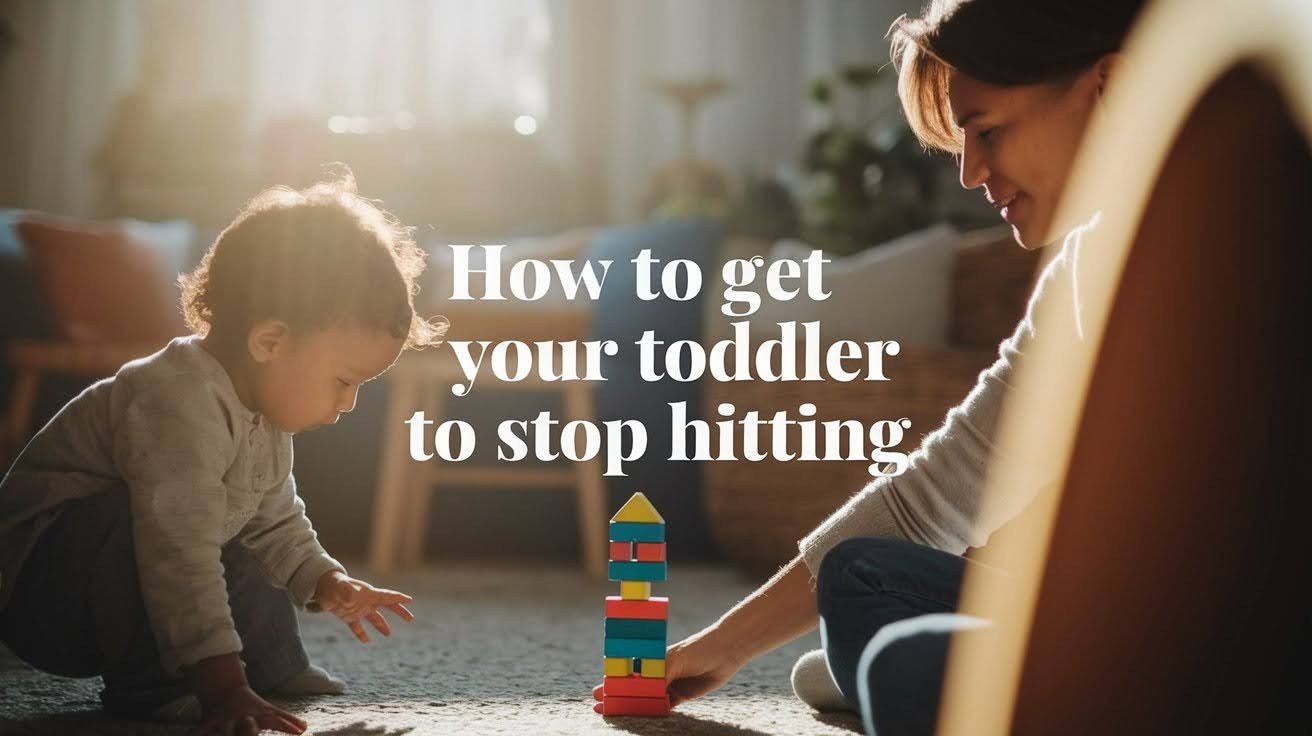When your toddler suddenly starts hitting, it can feel shocking and confusing. You’re not alone. This behavior is common between 18 months and 2 years and usually passes with the right guidance.
Stopping hitting takes patience, consistency, and understanding. By responding calmly and setting clear limits, you can address the behavior while teaching safer ways to express emotions.
This guide provides practical strategies to build gentle interactions and long-term social skills. With consistent support, your child can move past hitting and learn healthier ways to connect with others.
How to Stop Toddler Hitting in 7 Simple Steps?
Handling hitting effectively requires immediate, consistent responses. These steps focus on safety, teaching better choices, and building lasting positive behaviors.
Step 1: Remove and Set Clear Boundaries

Prioritize safety by removing your toddler from the situation immediately. Use calm, firm words like “hitting is not safe” and avoid long explanations. If necessary, gently hold their hands or create distance until they calm down.
Key actions: remove from the situation, use clear language, stay calm, create physical barriers, and end the activity temporarily.
Step 2: Show Alternative Behaviors

Teach your toddler what to do instead of hitting. Demonstrate gentle touches, hugs, or use words/signs to ask for help. Model these behaviors when your child is calm to reinforce learning.
Alternatives: gentle touches, simple words or signs, hugging, using indoor voices, pointing to what they want.
Step 3: Praise Positive Behavior

Immediately recognize and praise gentle or appropriate actions. Be specific: “You used gentle hands! That felt nice.” Positive reinforcement encourages toddlers to repeat good behaviors more than negative ones.
Step 4: Stay Consistent

Consistency is key. Every time a hit occurs, follow the same steps. Mixed messages confuse toddlers and make it harder for them to understand boundaries.
Step 5: Teach Emotional Awareness

Help your toddler identify feelings like anger, frustration, or excitement. Use phrases like “I see you’re angry” or “You feel upset.” Teaching emotions helps children express themselves without resorting to hitting.
Step 6: Redirect Energy

Sometimes toddlers hit because they have excess energy or are overstimulated. Offer alternatives like running, jumping, or using a stress ball. Physical outlets reduce frustration and channel energy safely.
Step 7: Model Calm Behavior

Children learn by watching adults. Stay calm and composed during conflicts. Demonstrating patience, gentle touch, and respectful communication teaches toddlers how to respond in similar situations.
What are the Root Causes of Toddler Hitting?
Here’s a clear list of root causes of toddler hitting in points:
- Frustration or Anger: Toddlers often hit when they can’t express strong emotions verbally.
- Seeking Attention: Hitting may be a way to get noticed by parents or caregivers.
- Testing Boundaries: Young children experiment to see what behaviors are acceptable.
- Imitating Others: Toddlers mimic the hitting they see from peers, siblings, or media.
- Overstimulation or Fatigue: Being tired, hungry, or overwhelmed can trigger aggressive behavior.
- Difficulty Sharing: Limited understanding of sharing toys or space can lead to hitting.
- Sensory Needs: Some toddlers hit to release excess energy or respond to sensory overload.
- Limited Communication Skills: Without words or signs, hitting becomes a way to express needs.
- Emotional Regulation Challenges: Toddlers are still learning to manage impulses and strong feelings.
When Toddler Hitting is Normal (And When to Seek Help)?
Hitting is a normal behavior for many toddlers as they are still learning to express their feelings and communicate their needs. It often happens out of frustration, excitement, or a desire for attention when they don’t yet have the words to express themselves.
Most toddlers outgrow hitting as they develop language and social skills. Consistently teaching gentle behavior and praising positive interactions helps them understand appropriate ways to express emotions.
Parents should seek help if hitting is frequent, aggressive, or causes harm to others. Persistent hitting beyond age three or difficulty controlling emotions may require guidance from a pediatrician or child development expert.
How to Handle Hitting in Different Situations?
Different situations call for slightly different responses, but the core principles stay the same. Here’s how to get your toddler to stop hitting in common scenarios.
- Stay Calm When Your Toddler Hits You: Take a deep breath and respond without anger. Say something simple like, “Ouch, that hurt,” instead of giving a long lecture.
- Step Away if Needed: Briefly remove yourself from the situation to keep both you and your child safe.
- Protect Other Children First: If your toddler hits another child, immediately ensure the other child is safe.
- Remove Your Toddler from the Situation: Calmly guide your child away so they can settle down and understand that hitting is not allowed.
- Help Your Toddler Make Amends: Encourage your child to apologize or do a small kind gesture to repair the situation.
- Prepare for Transitions: Give warnings before changes: “In five minutes, we’re leaving the playground,” and offer simple choices when possible.
- Praise Gentle Behavior: Whenever your toddler uses gentle hands or words, give immediate positive attention to reinforce good behavior.
Fast Tips to Prevent Toddler Hitting Before It Starts
Toddlers often hit out of frustration, curiosity, or a need for attention. By anticipating triggers and guiding them gently, you can prevent hitting before it happens. Here are 9 practical tips you can use every day:
- Stay Calm Yourself: Your calm tone and behavior model how your toddler should handle emotions.
- Set Clear Rules Early: Explain simply, “We use gentle hands,” so your child knows what’s expected.
- Offer Choices: Give small options like “Do you want to walk or be carried?” to reduce frustration and power struggles.
- Give Warnings Before Transitions: Let your child know what’s coming: “In five minutes, we’re leaving the playground.”
- Praise Gentle Behavior Often: Notice and celebrate moments of kindness to reinforce positive actions.
- Redirect Energy to Safe Activities: Encourage running, jumping, or using a stress ball instead of hitting.
- Teach Simple Words or Signs: Help your toddler express needs with words or signs like “stop,” “help,” or “more.”
- Limit Overstimulation: Avoid crowded or noisy situations that can overwhelm your child and trigger hitting.
- Spend One-on-One Time Daily: Focused attention reduces attention-seeking hitting and strengthens your bond.
Conclusion
Learning how to help your toddler stop hitting can feel challenging, but with patience, it’s absolutely possible. Using a simple three-step approach, you can provide immediate guidance while showing your child safer ways to express big emotions and connect with you.
Hitting is a normal part of toddler development. Your calm, consistent responses teach your child self-control and communication skills. Focus on guiding them toward gentle alternatives instead of just stopping the behavior, helping them understand how to express themselves safely.
Creating a supportive environment makes learning easier. Ensuring enough sleep, playtime, and emotional connection helps your toddler feel secure. Avoid harsh punishment trust and patient guidance will encourage your child to manage strong feelings and interact kindly with others.
Frequently Asked Questions
How long does it take to stop a toddler’s hitting behavior?
With consistent and patient guidance, most toddlers show noticeable improvement within 2-3 weeks. Complete resolution can take 1-2 months. Occasional hitting may still occur during stress, tiredness, or big changes, so gentle reminders remain important.
Should I ignore hitting behavior in toddlers?
No, ignoring hitting can be unsafe. Always intervene immediately, calmly explain that hitting hurts, set firm boundaries, and model gentle alternatives. Your consistent, patient responses teach your toddler safe ways to express frustration without hurting anyone.
Is it normal for 18-month-olds to hit their parents?
Yes, hitting often peaks between 18 months and 2 years as toddlers explore emotions and test boundaries. This is a normal developmental stage. With your calm, consistent guidance, your child will gradually learn safer ways to communicate.
What should I do if my toddler hits other children at daycare?
Collaborate closely with caregivers to maintain consistent expectations. Practice gentle interactions and sharing skills at home. Shorter play sessions and role-playing safe behaviors help your toddler understand limits while reinforcing positive social skills.
Can teething cause increased hitting in toddlers?
Yes, teething can make toddlers irritable and more likely to hit. Offer soothing relief, maintain your usual routines, and respond calmly. Consistency combined with extra patience helps your child manage dis
comfort without learning to hit as an outlet.







